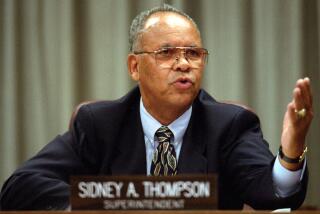Teachers Learn Lesson Not Found in a Book
- Share via
When she returned last month from a three-week stint in Japan with the Fulbright Memorial Fund Teacher Program, Laura Thompson knew she’d have to find creative ways to share what she learned with her class of seventh-graders.
“You have a brief window of opportunity to get their attention, and you have to make it good,” said Thompson, 33, a world history teacher at Las Flores Middle School in south Orange County.
Candy, she thought.
And she was right. That bagful of Japanese treats was all it took to get the group of 12-year-olds going, interrupting each other with their endless questions about teen life abroad as they sampled--and critiqued--a variety of munchies, including fish-flavored crackers and cinnamon-covered peppermints.
“Suddenly, they wanted to know about [Japanese] fashion and food and what school was like over there,” Thompson said. “They asked more questions than any of my adult friends or colleagues. And they wanted details.”
*
Their enthusiasm impressed Thompson, who was--along with Karen Swenson, a second-grade teacher from Rossmoor--among 200 educators across the country selected this year for the Japanese government-sponsored program, aimed at strengthening cultural ties between the countries’ teachers.
The prestigious award gives visiting teachers and administrators on the elementary and middle school levels a chance to meet Japanese officials and take workshops on Japanese life and culture. The program was launched in 1997 to mark the 50th anniversary of the U.S. Fulbright scholarships, which support exchanges of teachers and students internationally.
For three weeks in October, both women visited schools, businesses and cultural sites in Tokyo and Hiroshima and spent one night with a Japanese family. Now home, Thompson and Swenson have begun sharing what they learned in their classrooms, a step both teachers said has been challenging but worthwhile.
“It’s important to help students understand where they are coming from ethnically and where they are headed in the American culture,” said Swenson, noting that the majority of her students at Leal Elementary School in Cerritos are Asian.
Although they visited and observed different grade levels and schools in Japan, both women said they were struck by the students’ willingness to learn and how seriously they seemed to take their studies. A heavier workload and a more formal educational environment made the middle school classrooms stand out from the ones back home, Thompson said.
“The students respected school more,” she said. “A spokesperson would greet the teacher at the start of each class and say, ‘Thank you for the lesson you are about to teach us,’ and then they would end the class by thanking the teacher for what had been taught.”
*
Much of that dedication, however, is due to the six days per week that they must spend in school, Thompson said. And at the dismissal bell every day, Japanese middle school students begin a three-hour cram class to help prepare them for the entry examinations guarding the way to high school.
“It’s serious business over there,” she said.
Thompson and Swenson plan to set aside three weeks in their classes next month for an in-depth exploration of Japan’s history and culture. But already they have touched on certain customs, like decorative paper folding and the art of ikebana, or Japanese flower arranging.
Thompson recently wore a kimono to school and held a brief lesson on the clothing tradition, which led to a broader discussion about how Japanese students dress and why some of them take lessons in “tea ceremony.”
“They are incredibly curious,” she said. “But I’m proud to say they’re also quite respectful about what they don’t know or understand.”
Some aspects of Japanese education that didn’t intrigue Thompson? Teaching methods that emphasize lecturing over cooperative learning, for one, she said, and rotations that require teachers to change classrooms each period rather than students.
“I wouldn’t necessarily like that,” she said. “The rooms are rather plain because they belong to six teachers, not just one. And I use a lot of props, so it would be hard for me to take my show on the road.”
As for her students, Thompson said they weren’t thrilled with the Japanese requirement that all students from first through 12th grade spend 15 minutes a day cleaning their schools. Or the lack of school-sponsored social events, especially dances.
“Oh, and the fish crackers?” she said. “They didn’t care much for those.”
*
Two American instructors who visited Japan return with a different way of approaching education in their classrooms. Their second- and seventh-grade students discover how seriously
their counterparts view school.
More to Read
Sign up for Essential California
The most important California stories and recommendations in your inbox every morning.
You may occasionally receive promotional content from the Los Angeles Times.













